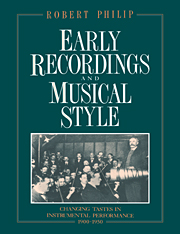Summary
Twenty years ago, music historians paid virtually no attention to early twentieth-century recordings. At best they were thought to have a period charm, but they certainly had nothing to teach the sophisticated modern musician about the history of performance. They were old enough to be old-fashioned, but too recent to be historical. Even now, the performing habits of the early twentieth century are, on the whole, habits which musicians would like to think they have outgrown. Scholars in the field of nineteenth-century performance have recently begun to take early recordings seriously, but study of them is in its infancy.
The reasons for examining early twentieth-century performance are compelling. In the first place, it is the earliest period from which the primary source material has survived. For earlier periods we have documents and instruments, but no performances (except as played by a few mechanical instruments, such as barrel organs). For the early twentieth century we have the performances themselves, often recorded by the composers or by musicians of whom they approved. We do not have to conjecture about how Elgar or Rachmaninoff or Stravinsky or Bartók performed their own works in the 1920s on the basis of documentary evidence; we know how they performed them, at least in the recording studio.
But the importance of early twentieth-century recordings extends far beyond composers' own performances.
- Type
- Chapter
- Information
- Early Recordings and Musical StyleChanging Tastes in Instrumental Performance, 1900–1950, pp. 1 - 4Publisher: Cambridge University PressPrint publication year: 1992



